谈谈Java8的函数式接口
Java8作为稳定版的老一代,作为不再被维护的一代,作为即将被抛弃的一代。它的新特性和较前面版本的变化是大的,是为后来者的开发提供了便利性,为后来者的代码开发提供了更为简洁的写法。今天我们就来一起学习下Java8的函数式接口。
什么是函数式接口
使用注解@FunctionalInterface标识,并且只包含一个抽象方法的接口是函数式接口。
函数式接口的分类(四大核心函数式接口)
1.Supplier供给型接口
简介
java.util.function.Supplier<T>接口定义了一个get的抽象方法,它没有参数,返回一个泛型T的对象,其函数描述符为() -> T,如果不接受入参,直接为我们生产一个指定的结果,那么就可以用Supplier,这类似于一个工厂方法,通常称为功能型接口。 Supplier不接受参数、只返回数据
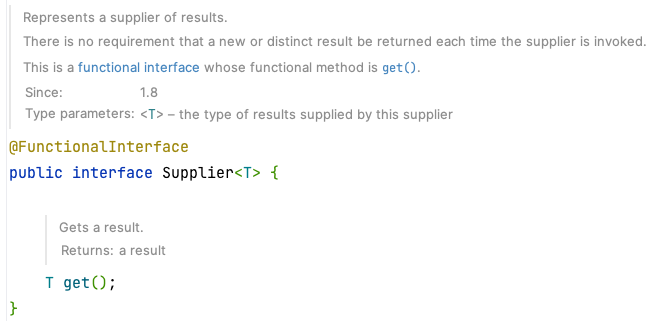
示例
外部配置文件Properties文件读取
1 | |
作为函数参数来使用
1 | |
2.Consumer消费型接口
简介
java.util.function.Consumer<T>接口定义了一个名叫accept的抽象方法,它接受泛型 T,没有返回值(void)。如果需要访问类型 T 的对象,并对其执行某些操作,可以使用这个接口,通常称为消费型接口。Consumer只接受一个参数、没有返回值
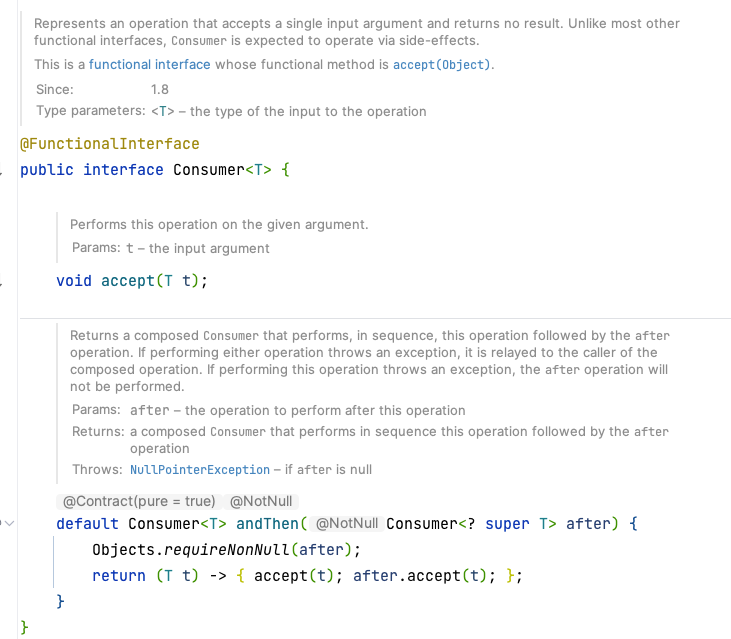
示例
消费字符串
1 | |
连续消费字符串
1 | |
3.Predicate断定型接口
简介
java.util.function.Predicate接口,是一个断定型接口,用于对指定类型的数据进行判断,从而得到一个判断结果(boolean类型的值)。
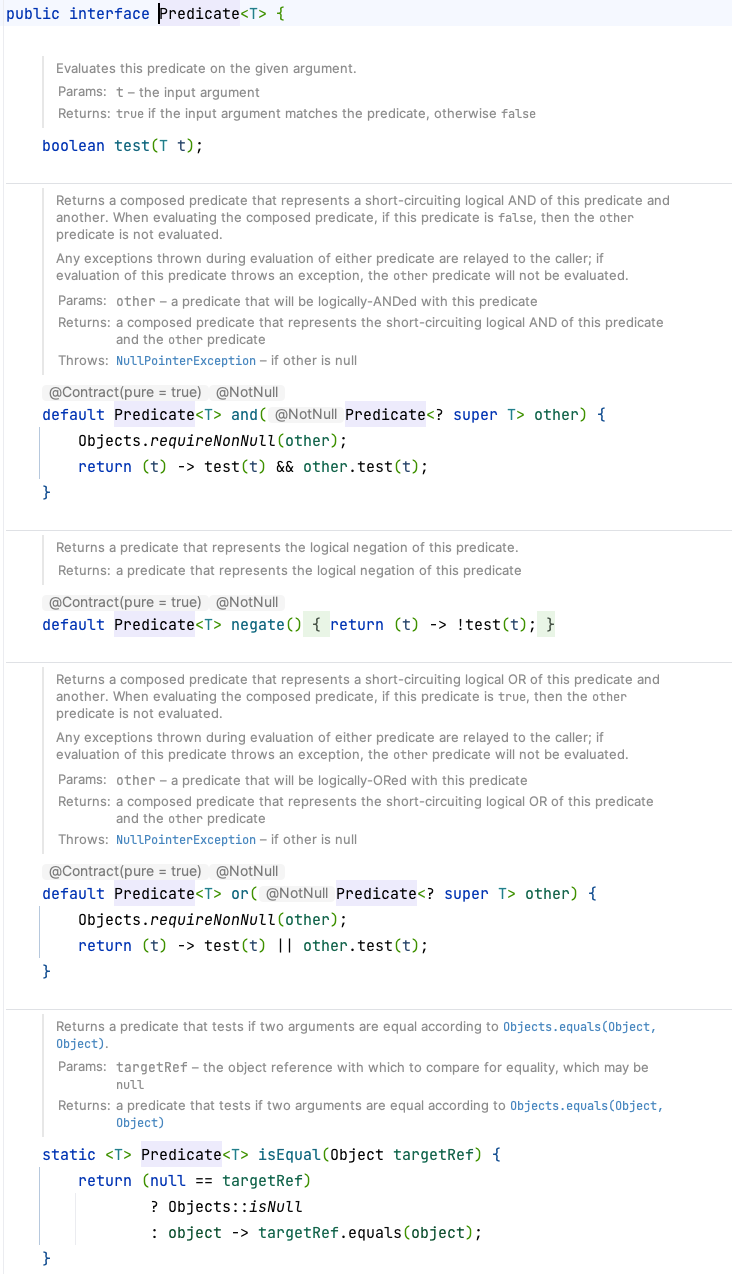
示例
boolean test(T t),用于条件判断
1
2
3
4
5
6
7
8
9
10
11
12
13
14
15
16
17public static void main(String[] args) {
boolean test = checkStr("test", s -> s.length() == 4);
System.out.println("test = " + test);
}
/**
* 判断字符串
*
* @param str str
* @param predicate predicate
* @return boolean
* @author gcoder
* @date 2023-04-21
*/
public static boolean checkStr(String str,Predicate<String> predicate) {
return predicate.test(str);
}Predicate<T> and(Predicate<? super T> other),用于将两个Prediccate进行逻辑与判断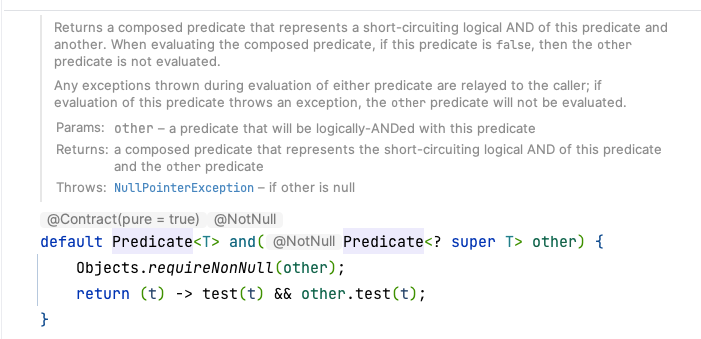
1
2
3
4
5
6
7
8
9
10
11
12
13
14
15
16
17
18public static void main(String[] args) {
boolean test = checkStr("test", s -> s.length() == 4, s -> s.equals("qwer"));
System.out.println("test = " + test);
}
/**
* 多个条件判断字符串
*
* @param str str
* @param p1 predicate
* @param p2 predicate
* @return boolean
* @author gcoder
* @date 2023-04-21
*/
public static boolean checkStr(String str, Predicate<String> p1, Predicate<String> p2) {
return p1.and(p2).test(str);
}Predicate<T> negate(),用于取反判断
1
2
3
4
5
6
7
8
9
10
11
12
13
14
15
16
17public static void main(String[] args) {
boolean test = checkStr2("test", s -> s.length() != 4);
System.out.println("test = " + test);
}
/**
* 取反判断字符串
*
* @param str str
* @param p1 predicate
* @return boolean
* @author gcoder
* @date 2023-04-21
*/
public static boolean checkStr2(String str, Predicate<String> p1) {
return p1.negate().test(str);
}Predicate<T> or(Predicate<? super T> other),用于两个Predicate的逻辑”或“判断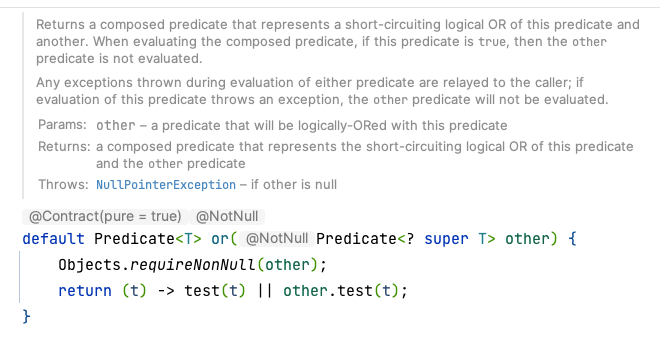
1
2
3
4
5
6
7
8
9
10
11
12
13
14
15
16
17
18public static void main(String[] args) {
boolean test = checkStr2("test", s -> s.length() == 4,s -> s.contains("z"));
System.out.println("test = " + test);
}
/**
* 多个条件判断字符串
*
* @param str str
* @param p1 predicate
* @param p2 predicate
* @return boolean
* @author gcoder
* @date 2023-04-21
*/
public static boolean checkStr2(String str, Predicate<String> p1, Predicate<String> p2) {
return p1.or(p2).test(str);
}
4.Function函数型接口
简介
java.util.function.Function接口,是一个函数型接口,用来根据一个类型的数据得到另外一个类型的数据
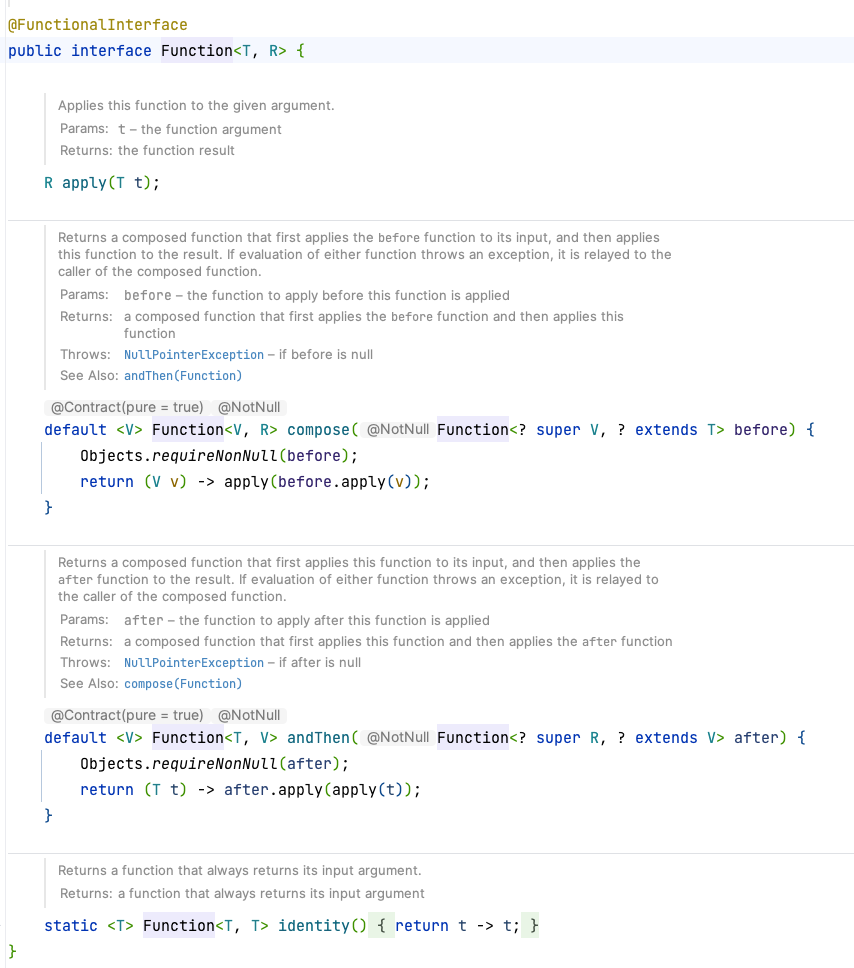
示例
抽象方法
R apply(T t),根据类型T的参数获取类型R的结果
1
2
3
4
5
6
7
8
9
10
11
12
13
14
15
16
17public static void main(String[] args) {
Integer integer = applyMethod("12345", Integer::parseInt);
System.out.println("integer = " + integer);
}
/**
* 字符串整数的转换
*
* @param str str
* @param function function
* @return Integer
* @author gaohuiwu
* @date 2023-04-21
*/
public static Integer applyMethod(String str, Function<String, Integer> function) {
return function.apply(str);
}<V> Function<V, R> compose(Function<? super V, ? extends T> before),获取apply的function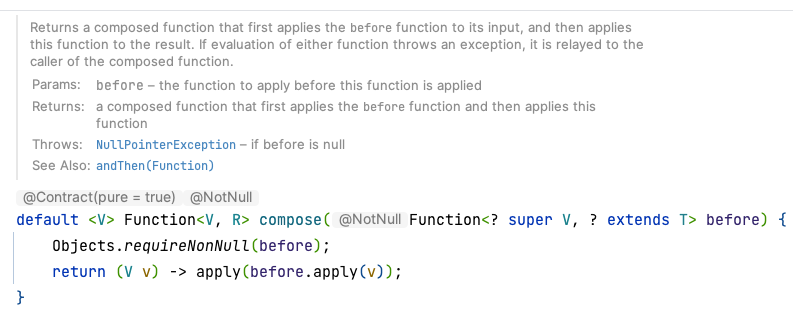
1
2
3
4
5
6
7
8
9
10
11
12
13
14
15
16
17
18public static void main(String[] args) {
String s1 = applyMethod("12345", s -> s + "777", s -> s + "666");
System.out.println("s1 = " + s1);
}
/**
* 先执行前置函数
*
* @param str str
* @param f1 function
* @param f2 function
* @return Integer
* @author gaohuiwu
* @date 2023-04-21
*/
public static String applyMethod(String str, Function<String, String> f1, Function<String, String> f2) {
return f1.compose(f2).apply(str);
}<V> Function<T, V> andThen(Function<? super R, ? extends V> after),用来进行组合操作,即:”先做什么,再做什么“的场景
1
2
3
4
5
6
7
8
9
10
11
12
13
14
15
16
17
18public static void main(String[] args) {
String s1 = applyMethod2("12345", s -> s + "777", s -> s + "666");
System.out.println("s1 = " + s1);
}
/**
* 执行后置函数
*
* @param str str
* @param f1 function
* @param f2 function
* @return Integer
* @author gaohuiwu
* @date 2023-04-21
*/
public static String applyMethod2(String str, Function<String, String> f1, Function<String, String> f2) {
return f1.andThen(f2).apply(str);
}
以上就是四大核心函数式接口了,在我们的代码开发过程中,实际上就可以借这些代码来简化我们的代码,除去复杂的多重if判断的场景等。函数式编程是比较自由的,并且它的灵活性很高,也够独立,所以善用函数式编程会让我们的编码更加的简洁美好,可读性更高。
今天的分享就到这了~谢谢阅读!